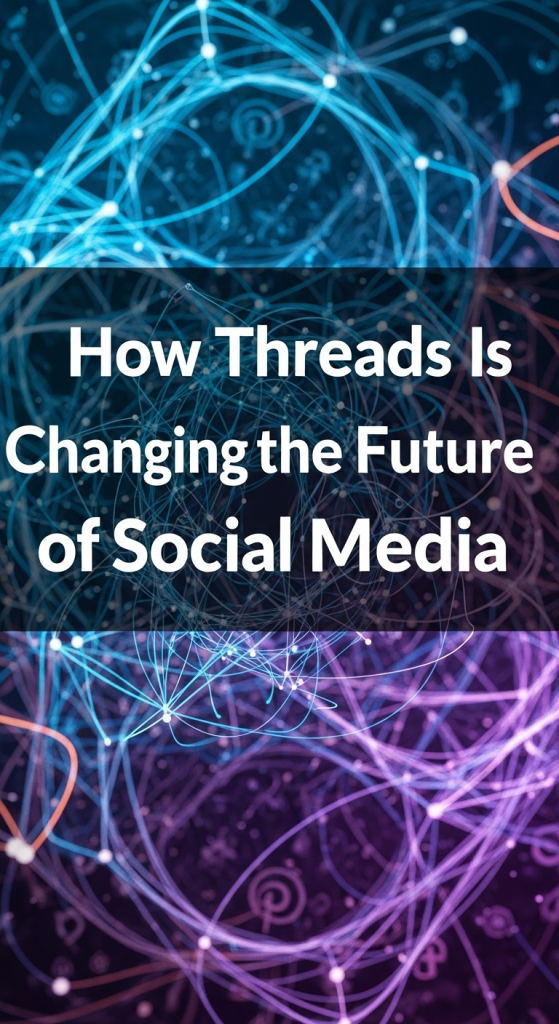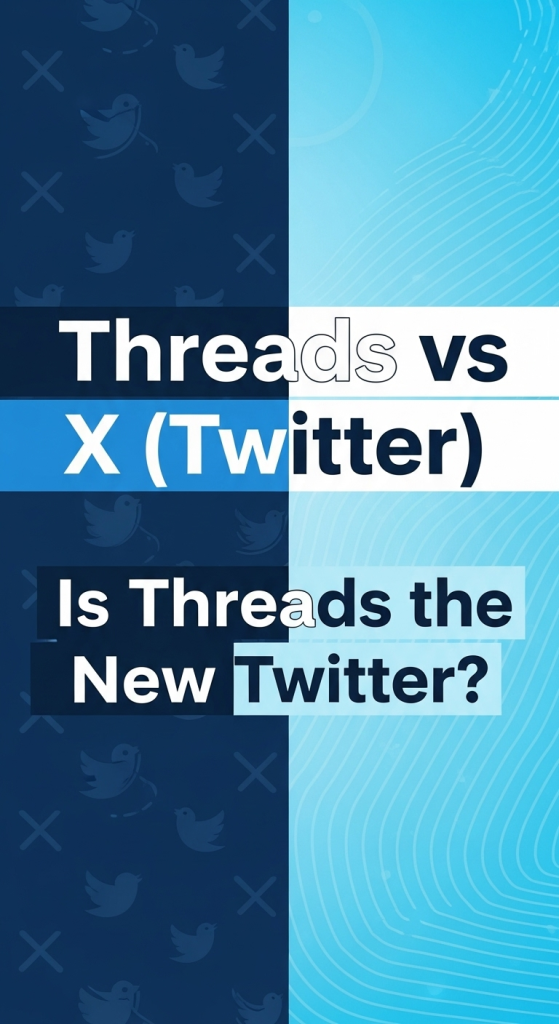
The launch of Instagram Threads has ignited a firestorm of discussion about the future of social media, creating a massive Threads app impact that’s impossible to ignore. It immediately forced us all to ask: is Threads the new Twitter? But the real story is far more complex than a simple “Threads vs X (Twitter)” deathmatch. This deep dive explores Meta’s grand strategy with its new text-based platform, the revolutionary potential of its connection to a decentralized social network via the Fediverse and the ActivityPub protocol, and whether this ambitious gamble by Mark Zuckerberg will actually succeed long-term. The ground beneath our digital feet is shifting, and Threads is, without a doubt, the epicenter of the tremor.
The Launch Heard ‘Round the World
Remember early July 2023? It felt like the entire internet held its breath for a moment. In a landscape dominated by incumbents and scarred by the chaotic transformation of Twitter into X, Meta, the behemoth behind Facebook and Instagram, made its move. With a flick of a switch, Instagram Threads was born.
It wasn’t just another app launch; it was a phenomenon.
Leveraging its colossal Instagram user base, Meta executed what might be the most seamless and explosive user acquisition in tech history. All you had to do was tap a few buttons within your Instagram app, and voilà, your profile, username, and even your network of followers were ported over to a shiny new platform. There was no need to build a social graph from scratch, no agonizing over a clever username that wasn’t already taken. It was frictionless.
The numbers were, frankly, staggering:
- 10 million users in 7 hours.
- 30 million users in 24 hours.
- 100 million users in just 5 days.
For a brief, heady period, Threads was the only thing anyone was talking about. Feeds were filled with a strange, almost euphoric energy. It was a mix of refugees from the increasingly volatile X, curious Instagrammers dipping their toes into text-based conversation, and brands scrambling to stake their claim on the new digital frontier. The tone was noticeably different—lighter, more conversational, and less… angry. Adam Mosseri, the head of Instagram, actively communicated with users on the platform, promising a “less intensely political” and more friendly public square.
But as with any meteoric rise, a gravitational pull was inevitable. The initial novelty wore off. Users began to notice the missing features—a functional search, hashtags, a chronological feed (which was later added), direct messages, and a desktop version. The user numbers, while still massive, saw a significant drop in daily active engagement. The question quickly shifted from “Is this the end of Twitter?” to a more skeptical, “Is this just another flash in the pan, like Clubhouse?”
This initial boom-and-bust cycle, however, masks the true significance of what Threads represents. Its launch wasn’t just about capturing disgruntled Twitter users; it was the first, very public move in a much larger, more audacious game that could redefine the very architecture of the internet.
Threads vs X (Twitter) – Is Threads the New Twitter?

It’s the comparison everyone immediately made, and for good reason. The user interface, the short text-based posts, the “reposts” (instead of retweets), the focus on public conversation—it was all unapologetically familiar. On the surface, Threads looked like a cleaned-up, minimalist clone of early Twitter. But to say it’s just a replacement is to miss the fundamental differences in philosophy, strategy, and technology that are already carving out two very different paths for these platforms.
A Tale of Two Platforms: The Core Differences
Let’s break down the head-to-head. It’s not just about features; it’s about ethos.
| Feature / Aspect | Threads (by Meta) | X (formerly Twitter) |
|---|---|---|
| User Base Origin | Leveraged from Instagram’s 2+ billion users. Inherently visual-first user base now exploring text. | Built organically over 15+ years as a text-first, news-driven platform. |
| Platform Vibe | Intentionally more positive, conversational, and community-focused. Less emphasis on hard news and politics. | A “digital town square” for everything: breaking news, politics, niche communities, conflict, and entertainment. |
| Integration | Deeply tied to the Instagram ecosystem. Your Threads handle is your Instagram handle. | Largely a standalone platform, though it has integrations with other services. |
| Monetization | Currently ad-free. Monetization plans are in the works but are expected to be integrated with Meta’s existing ad engine. | Heavily reliant on advertising, with a push towards subscription models like X Premium (Blue). |
| Content Moderation | Leverages Meta’s massive, established content moderation infrastructure. Tends to be more stringent. | A “free speech absolutist” approach under Elon Musk, leading to more volatile and less predictable moderation. |
| The “Secret Sauce” | Integration with the Fediverse via the ActivityPub protocol (more on this in a moment!). | Features like Community Notes, Spaces (live audio), and a focus on video and creator payouts. |
So, is Threads the new Twitter? The answer is a complicated no. It’s competing for the same function—a public, text-based conversation platform—but it’s not aiming to be a one-for-one replacement of its culture.
Adam Mosseri has been clear that he doesn’t want Threads to become the go-to place for breaking news and political discourse, the very things that made Twitter indispensable to journalists, activists, and politicians. This is a deliberate, calculated move. Meta understands the brand-safety nightmare and the moderation quagmire that comes with being the world’s primary political battlefield. Instead, they’re aiming for the “culture” space: sports, fashion, music, and general conversation. They want the water cooler, not the war room.
This divergence is crucial. While X doubles down on being an “everything app” with a hard-edged, anything-goes culture, Threads is trying to build a friendlier, more curated space. Whether that’s a sustainable strategy remains to be seen. Can a public square truly thrive without being the primary source for what’s happening in the world right now? That’s one of the biggest questions shaping the future of social media.
What is the Fediverse and How Does Threads Use It?
Okay, here’s where things get really interesting. If you look past the surface-level Twitter rivalry, you find the truly revolutionary aspect of Threads. It’s a single word that has the potential to upend the last decade of social media: Fediverse.
This is the core of the Threads app impact. For years, social media has been defined by “walled gardens.” Your posts on Facebook stay on Facebook. The tweets you create stay on Twitter. Your TikToks stay on TikTok. You can’t follow a Twitter user from your Facebook account. These platforms are closed ecosystems, proprietary fortresses designed to keep you inside.
Meta, arguably the king of the walled garden, is doing something completely radical with Threads: they are building a gate.
Demystifying the Fediverse and the ActivityPub Protocol
Let’s try to demystify this. It sounds complex, but the concept is surprisingly simple if you think about email.
You can have a Gmail account, and I can have an Outlook account, and my friend can have a Yahoo account. We can all send and receive emails from each other seamlessly. Why? Because all these different services use a common, open standard—a protocol (like SMTP for sending mail)—to communicate. They’re all part of the same federated network of email.
The Fediverse (a portmanteau of “federated” and “universe”) aims to do the same for social media. It’s a collection of thousands of independent social media servers, often called “instances,” that can all talk to each other using a shared protocol. That protocol is called ActivityPub.
Mastodon is the most well-known platform in the Fediverse. It looks a lot like Twitter, but instead of one central company running everything, it’s made up of thousands of independent servers, each with its own rules and moderation, all connected through ActivityPub. You could be on a Mastodon server dedicated to book lovers, and you could still follow and interact with someone on a server for photographers, because they both speak the same digital language.
This is the world Threads is plugging into.
How Threads’ Integration with the Fediverse Changes Everything
Meta social media is now, for the first time, building a bridge to an open, decentralized social network. When the integration is complete, a Threads user will (in theory) be able to follow and interact with a user on a Mastodon server, and vice-versa, without either person having to leave their preferred platform.
Think about the implications of that.
- Portability of Identity: If you decide you don’t like Threads anymore, you could potentially migrate your profile and your followers to another server in the Fediverse that also uses the ActivityPub protocol. This fundamentally breaks the lock-in that platforms have relied on for years. You are no longer trapped in Mark Zuckerberg’s or Elon Musk’s playground.
- Unprecedented Reach: For creators on smaller, niche Fediverse instances, the ability to be followed by users from a platform with hundreds of millions of people is a game-changer. It brings a massive new audience to the open web.
- A New Standard: By adopting ActivityPub, Meta is effectively legitimizing it as the standard for decentralized social networking. This could force other platforms (maybe even competitors like Bluesky, which uses its own “AT Protocol”) to consider adopting it to stay relevant.
This move has been met with both excitement and extreme skepticism in the Fediverse community. Many are thrilled at the prospect of mainstream adoption. Others are terrified of the “Embrace, Extend, Extinguish” strategy that big tech has used in the past, fearing that Meta will co-opt the open standard and eventually bend it to its will. It’s a classic David vs. Goliath story, except David just invited Goliath into his house for dinner.
How Will Threads Affect Marketing?
Whenever a new platform explodes onto the scene, the marketing world scrambles to figure it out. How will Threads affect marketing? The initial rush was chaotic, with brands from Wendy’s to Gucci jumping in, trying to capture the “lightning in a bottle” vibe of a new social space.
The rules of engagement on Threads are noticeably different from the polished, curated world of Instagram or the chaotic, meme-heavy landscape of X.
A New Playbook for Brands
The early days of Threads marketing have been defined by a more human, conversational, and often unhinged tone. Brands that have succeeded are the ones that dropped the corporate jargon and engaged like real people. It’s less about broadcast and more about conversation.
Here’s a comparison of the marketing approach:
| Marketing Strategy | On Threads | On X (Twitter) |
|---|---|---|
| Tone of Voice | Conversational, authentic, often self-deprecating and humorous. Community-focused. | Can be similar, but also serves as a platform for customer service, official announcements, and rapid-response PR. |
| Primary Goal | Brand building and community engagement. Fostering a personality. | A mix of brand awareness, lead generation, customer support, and driving traffic via links. |
| Content Type | Text-based quips, questions to the community, behind-the-scenes content, and engaging in threads with other users/brands. | A mix of text, links to articles, polls, video clips, and live audio (Spaces). |
| Metrics for Success | Engagement rate (replies, likes), community growth, and qualitative brand sentiment. | Clicks, impressions, retweets, follower growth, and conversion rates from ads. |
The lack of traditional ads (for now) and robust analytics has forced marketers to go back to basics: creating genuinely good content that people want to engage with. It’s a refreshing change of pace, but it also presents challenges. Measuring ROI is difficult without direct link tracking or sophisticated ad tools.
The long-term marketing potential of Threads will depend on two things:
- Sustainable Engagement: Can the platform retain a critical mass of active users for brands to talk to?
- Monetization Model: How will Meta integrate ads? Will they be intrusive, or will they feel native to the platform’s conversational flow?
For now, the advice for marketers is simple: be human. Join conversations, don’t just start them. Have a personality. The era of just scheduling promotional posts seems to be, at least on Threads, on hold.
Where Do Bluesky and Mastodon Fit?
Threads didn’t just challenge X; it landed in the middle of an already simmering movement towards decentralized alternatives. For a year, the conversation had been dominated by two other contenders: Mastodon and Bluesky.
- Mastodon: As mentioned, Mastodon is the flagship of the existing Fediverse. It’s open-source, run by non-profits and volunteers, and fiercely independent. Its user base is smaller but highly dedicated to the principles of decentralization and user ownership. For them, Threads is a corporate trojan horse.
- Bluesky: Backed by Twitter’s co-founder Jack Dorsey, Bluesky is another project aimed at creating a decentralized social network. However, it uses its own open-source framework, the AT Protocol, which is not compatible with ActivityPub. It gained traction through an invite-only system, cultivating a unique culture often described as “weird Twitter.”
The emergence of Threads has completely upended this landscape. It has dwarfed both Mastodon and Bluesky in sheer user numbers. However, it has also acted as a giant, mainstream advertisement for the very concept of decentralization. More people know what the Fediverse is today than ever before, and that’s a direct result of the Threads app impact.
The future isn’t necessarily a winner-take-all scenario. We might be heading towards a multi-polar social media world:
- X remains the chaotic, high-stakes arena for news and politics.
- Threads becomes the mainstream, “brand-safe” conversational layer, integrated with Instagram and the Fediverse.
- Bluesky cultivates its own unique, semi-independent network with a distinct culture.
- Mastodon and the rest of the Fediverse continue to be the home for users who prioritize true decentralization and community-owned infrastructure above all else.
Will Threads Succeed Long Term?
This brings us to the multi-billion dollar question: Will Threads succeed long term? The explosive launch guaranteed it a place in the history books, but longevity in the brutal world of social media is never guaranteed. Its fate hinges on navigating several critical challenges.
The Hurdles on the Road to Dominance
- The Retention Riddle: The biggest immediate challenge is keeping users engaged. The initial drop-off after the launch was significant. Threads needs to evolve beyond being a novelty and become a daily habit. This means continuously shipping essential features, fostering unique communities, and giving people a compelling reason to open the app every day. Can it create an indispensable experience?
- The Monetization Tightrope: Meta is a business, and eventually, Threads needs to make money. How Mark Zuckerberg and his team introduce ads will be a make-or-break moment. If they are too aggressive, they could alienate the user base that enjoys the current clean experience. The integration must be thoughtful and add value, not just clutter the feed.
- The Culture Clash with the Fediverse: The integration with the decentralized social network is technically complex but culturally even more so. The anti-corporate, privacy-focused ethos of many Fediverse users is diametrically opposed to Meta’s data-driven business model. We’re already seeing Mastodon server administrators preemptively blocking the Threads server. Navigating this cultural divide will require deft diplomacy from Adam Mosseri and his team.
- The Content Moderation Nightmare: Moderating a platform with hundreds of millions of users is already a Herculean task. Now imagine moderating a platform that interacts with thousands of independent servers, each with its own set of rules. How does Meta handle harassment or illegal content that originates on a small Fediverse server but is seen by a Threads user? This is an entirely new frontier of trust and safety challenges.
Despite these hurdles, the argument for Threads’ long-term success is powerful. The connection to Instagram provides a near-bottomless well of potential users. Meta’s financial and technical resources are virtually unlimited. And by embracing the ActivityPub protocol, they have a chance to not just compete in the current paradigm but to define the next one.
The Future is Federated
So, how is Threads changing the future of social media?
It’s doing so by forcing the entire industry to confront a new reality. Regardless of whether Threads itself becomes the dominant text-based platform, it has already changed the game. By a massive, centralized corporation like Meta adopting an open, decentralized protocol, the concept of a federated social web has been catapulted from a niche, technical ideal into a mainstream possibility.
The very idea that you could one day leave a social media platform and take your social graph—your followers—with you is revolutionary. It shifts power, however slightly, away from the platform and back towards the user.
The Threads app impact is not just about the Threads vs X (Twitter) battle. It’s about challenging the very notion of a social network as a walled garden. Threads about introducing hundreds of millions of people to the idea of a decentralized social network. It’s about forcing a conversation about interoperability, data portability, and what we, as users, should expect from the platforms that host our digital lives.
The road ahead for Threads is long and uncertain. It may succeed beyond anyone’s wildest dreams, or it may fade into the background as another interesting Meta experiment. But one thing is certain: by building a gate in its walled garden, Meta has changed the landscape forever. The future of social media is no longer a question of which single app will win, but how all of them will, one day, learn to talk to each other. The future, it seems, is federated.




Add your first comment to this post